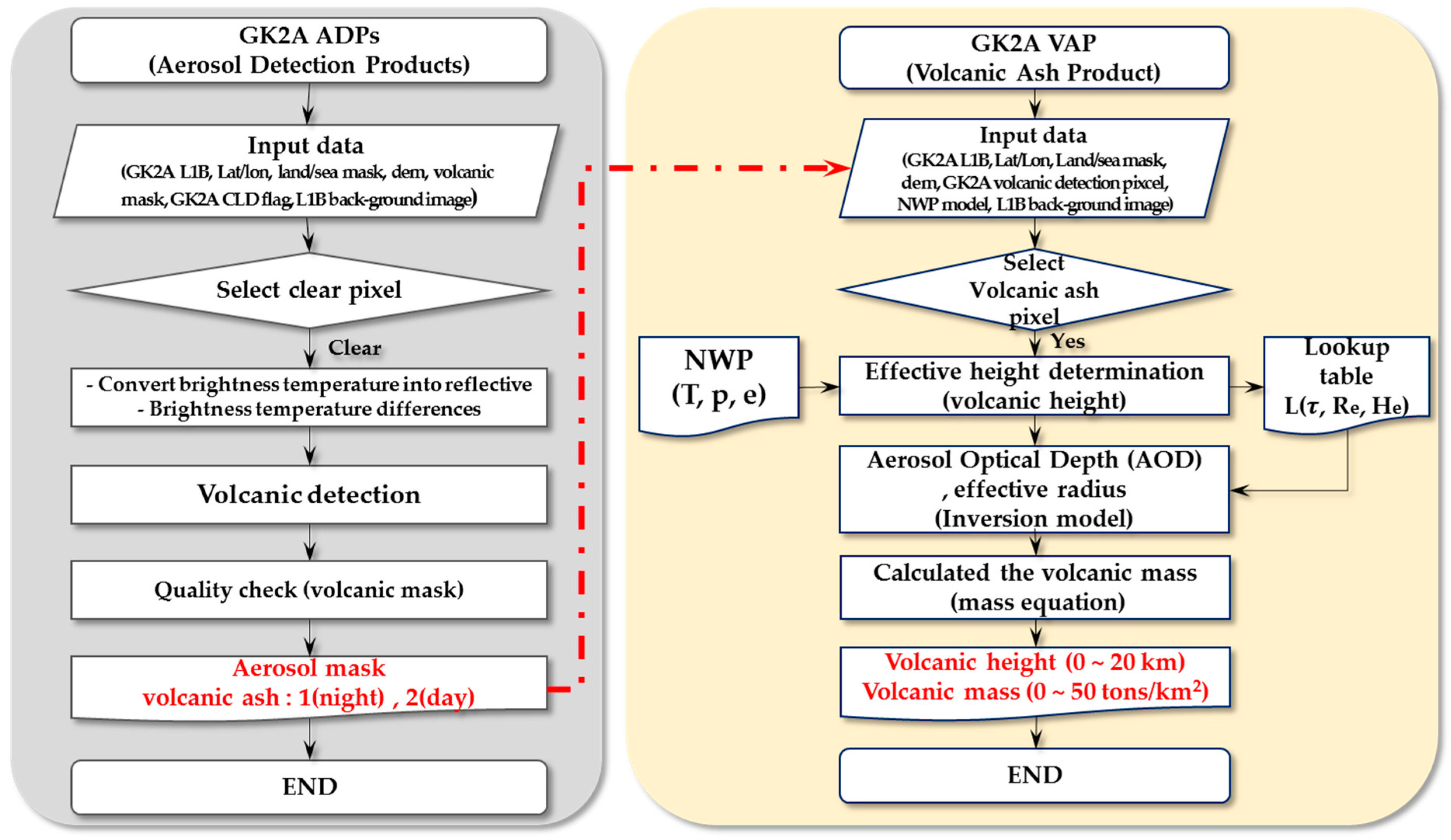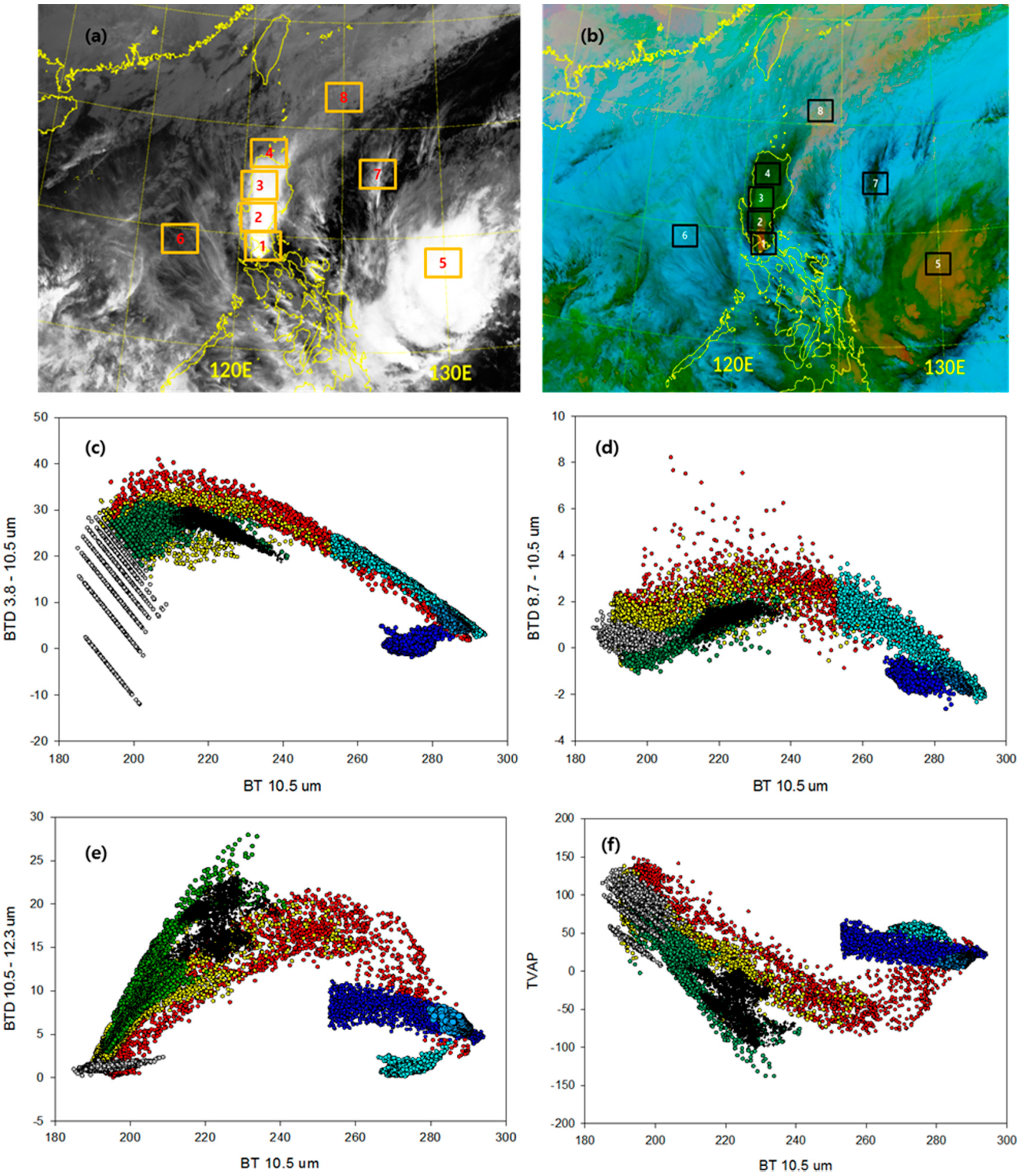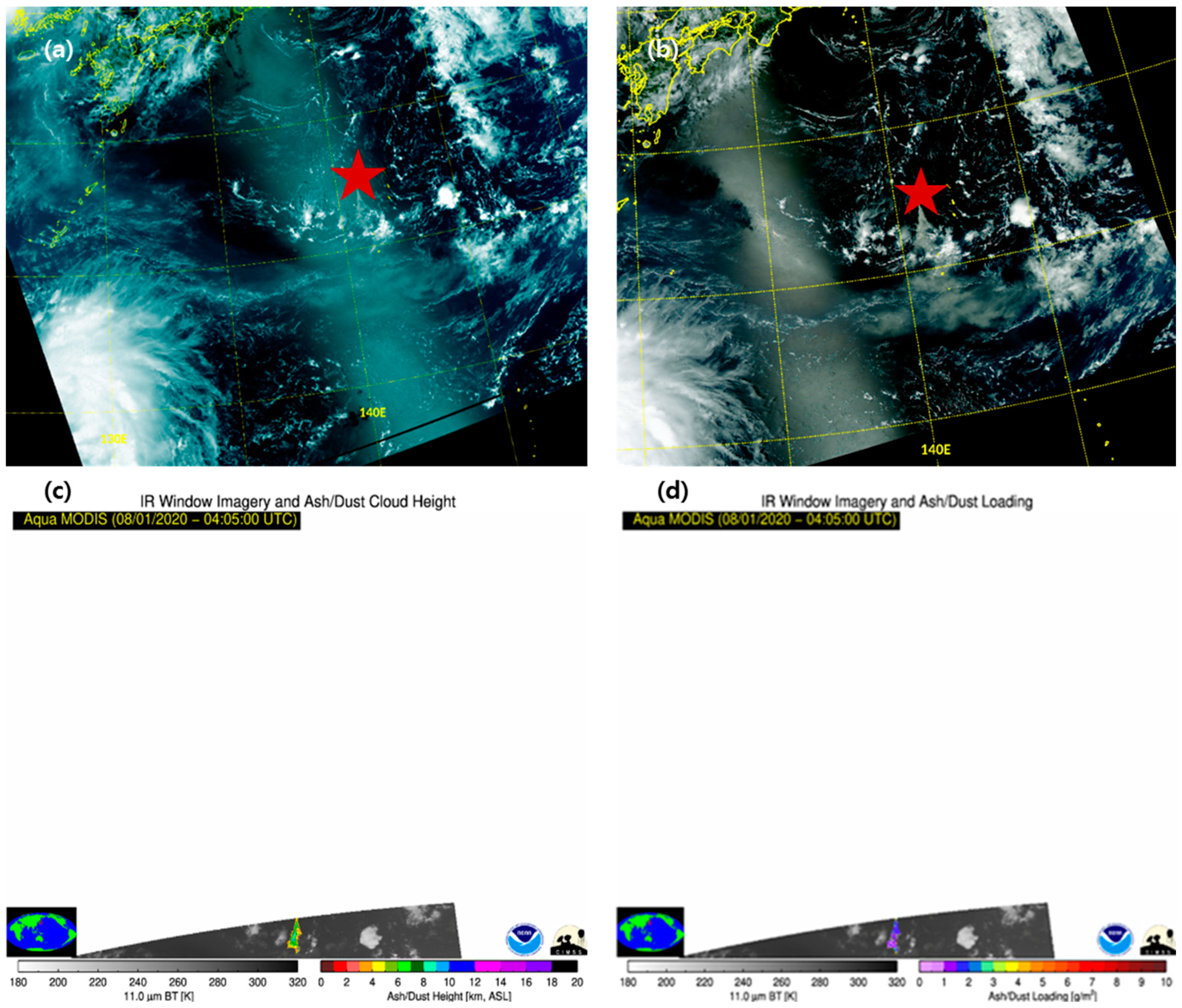Enhanced Accuracy of Airborne Volcanic Ash Detection Using the GEOKOMPSAT-2A Satellite
Abstract
1. Introduction
2. Data and Methods
2.1. Data
2.1.1. GEOKOMPSAT-2A (GK-2A)
2.1.2. Validation Datasets
2.1.3. Volcanic Ash 2020
2.2. Method
2.2.1. Volcanic Ash Algorithm
Aerosol Optical Depth Lookup Table
Background Composite Image
Cloud Masking and Quality Assurance
Volcanic Ash Detection Using a Multi-Channel Threshold Test
Determination of the Effective Volcanic Ash Cloud Height
Calculation of the Volcanic Ash Mass Loading
3. Results
3.1. Algorithm Performance
3.1.1. Case 1: Taal Volcano Eruption (12 January 2020)
3.1.2. Case 2: Nishinoshima Volcanic Eruption (30 July–2 August 2020)
3.2. Validation
3.2.1. Case 1: Taal Volcano Eruption (12 January 2020)
3.2.2. Case 2: Nishinoshima Volcano Eruption (31 July–2 August 2020)
3.3. Limitations of GK2A/AMI VAP Algorithms
4. Conclusions
Author Contributions
Funding
Institutional Review Board Statement
Informed Consent Statement
Data Availability Statement
Acknowledgments
Conflicts of Interest
References
- Watkin, S. The application of AVHRR data for the detection of volcanic ash in a Volcanic Ash Advisory Centre. Meteorol. Appl. 2003, 10, 301–311. [Google Scholar] [CrossRef]
- Cantor, R. Complete avoidance of volcanic ash is only procedure that guarantees flight safety. ICAO J. 1998, 53, 18. [Google Scholar]
- Kinoshita, K.; Tsuchida, S.; Kanagaki, C.; Tupper, A.; Corpuz, E.; Laguerta, E. Ground-based real time monitoring of eruption clouds in the western Pacific. In Proceedings of the 2nd International Conference on Volcanic Ash and Aviation Safety, Alexandria, VA, USA, 21–24 June 2004. [Google Scholar]
- Prata, F.; Bluth, G.; Rose, B.; Schneider, D.; Tupper, A. Comments on “Failures in detecting volcanic ash from a satellite-based technique. Remote Sens. Environ. 2001, 78, 341–346. [Google Scholar] [CrossRef]
- Tupper, A.; Ernst, G.; Textor, C.; Kinoshita, K.; Oswalt, J.S.; Rosenfeld, D. Volcanic cloud conceptual models for Volcanic Ash Advisory Centre operations. In Proceedings of the 2nd International Conference on Volcanic Ash and Aviation Safety, Alexandria, VA, USA, 21–24 June 2004. [Google Scholar]
- Oppenheimer, C.; Francis, P.; Stix, J. Depletion rates of sulfur dioxide in tropospheric volcanic plumes. Geophys. Res. Lett. 1998, 25, 2671–2674. [Google Scholar] [CrossRef]
- Prata, A. Observations of volcanic ash clouds in the 10–12 μm window using AVHRR/2 data. Int. J. Remote Sens. 1989, 10, 751–761. [Google Scholar] [CrossRef]
- Rose, W.I.; Schneider, D.J. Satellite images offer aircraft protection from volcanic ash clouds. EOS Trans. Am. Geophys. Union 1996, 77, 529–532. [Google Scholar] [CrossRef]
- Davies, M.A.; Rose, W.I. GOES imagery fills gaps in Montserrat volcanic cloud observations. EOS Trans. Am. Geophys. Union 1998, 79, 505–507. [Google Scholar] [CrossRef]
- Rose, W.I.; Mayberry, G.C. Use of GOES thermal infrared imagery for eruption scale measurements, Soufriere Hills, Montserrat. Geophys. Res. Lett. 2000, 27, 3097–3100. [Google Scholar] [CrossRef]
- Holasek, R.E.; Rose, W.I. Anatomy of the 1986 Augustine volcano eruptions as recorded by multispectral image processing of digital AVHRR weather satellite data. Bull. Volcanol. 1991, 53, 420–435. [Google Scholar] [CrossRef]
- Ellrod, G.P.; Connell, B.H.; Hillger, D.W. Improved detection of airborne volcanic ash using multi-spectral infrared satellite data. J. Geophys. Res. 2003, 108. [Google Scholar] [CrossRef]
- Lee, K.H.; Lee, K.T. Volcanic Ash Retrieval Using a New Geostationary Satellite. Int. Arch. Photogramm. Remote Sens. Spat. Inf. Sci. 2015, 40, 67. [Google Scholar] [CrossRef]
- Mosher, F.R. Four channel volcanic ash detection algorithm. In Proceedings of the 10th Conference on Satellite Meteorology and Oceanography, Long Beach, CA, USA, 9–14 January 2000. [Google Scholar]
- Turk, F.J.; Mostovoy, G.V.; Anantharaj, V.G. Soil moisture sensitivity to NRL-blend high-resolution precipitation products: Analysis of simulations with two land surface models. IEEE J. Sel. Top. Appl. Earth Obs. Remote Sens. 2009, 3, 32–48. [Google Scholar] [CrossRef]
- Ellrod, G.P. Detection and Analysis of Fog at Night Using GOES Multispectral Infrared Imagery; US Department of Commerce, National Oceanic and Atmospheric Administration: Silver Spring, MD, USA, 1994. [Google Scholar]
- Kleespies, T.J. The retrieval of marine stratiform cloud properties from multiple observations in the 3.9-µm window under conditions of varying solar illumination. J. Appl. Meteorol. 1995, 34, 1512–1524. [Google Scholar] [CrossRef][Green Version]
- Arking, A.; Childs, J.D. Retrieval of cloud cover parameters from multispectral satellite images. J. Clim. Appl. Meterology 1985, 24, 322–333. [Google Scholar] [CrossRef]
- Marchese, F.; Falconieri, A.; Pergola, N.; Tramutoli, V. A retrospective analysis of the Shinmoedake (Japan) eruption of 26–27 January 2011 by means of Japanese geostationary satellite data. J. Volcanol. Geotherm. Res. 2014, 269, 1–13. [Google Scholar] [CrossRef]
- Marchese, F.; Genzano, N.; Neri, M.; Falconieri, A.; Mazzeo, G.; Pergola, N. A Multi-channel algorithm for mapping volcanic thermal anomalies by means of Sentinel-2 MSI and Landsat-8 OLI data. Remote Sens. 2019, 11, 2876. [Google Scholar] [CrossRef]
- Ishii, K.; Hayashi, Y.; Shimbori, T. Using Himawari-8, estimation of SO2 cloud altitude at Aso volcano eruption, on October 8, 2016. Earth Planets Space 2018, 70, 1–9. [Google Scholar] [CrossRef]
- De Laat, A.; Vazquez-Navarro, M.; Theys, N.; Stammes, P. Analysis of properties of the 19 February 2018 volcanic eruption of Mount Sinabung in S5P/TROPOMI and Himawari satellite data. Nat. Hazards Earth Syst. Sci. 2020, 20, 1203–1217. [Google Scholar] [CrossRef]
- Krotkov, N.A.; McClure, B.; Dickerson, R.; Carn, S.; Li, C.; Bhartia, P.K.; Lu, D. Ozone Monitoring Instrument (OMI) SO2 validation over NE China. J. Geophys. Res. 2008, 113, 16–40. [Google Scholar]
- Krotkov, N.A.; Carn, S.A.; Krueger, A.J.; Bhartia, P.K.; Yang, K. Band residual difference algorithm for retrieval of SO2 from the aura ozone monitoring instrument (OMI). IEEE Trans. Geosci. Remote Sens. 2006, 44, 1259–1266. [Google Scholar] [CrossRef]
- Sanders, A.F.J.; de Haan, J.F.; Sneep, M.; Apituley, A.; Stammes, P.; Vieitez, M.O.; Tilstra, L.G.; Tuinder, O.N.E.; Koning, C.E.; Veefkind, J.P. Evaluation of the operational Aerosol Layer Height retrieval algorithm for Sentinel-5 Precursor: Application to O2 A band observations from GOME-2A. Atmos. Meas. Tech. 2015, 8, 4947–4977. [Google Scholar] [CrossRef]
- De Graaf, M.; Tuinder, O.; Tilstra, G.; Penning de Vries, M. Algorithm Theoretical Basis Document for the GOME-2 Aerosol Products; O3MSAF/KNMI/ATBD/002, 2.1; EUMETSAT: Darmstadt, Germany, 2013. [Google Scholar]
- Li, C.; Krotkov, N.A.; Carn, S.; Zhang, Y.; Spurr, R.J.; Joiner, J. New-generation NASA Aura Ozone Monitoring Instrument (OMI) volcanic SO2 dataset: Algorithm description, initial results, and continuation with the Suomi-NPP Ozone Mapping and Profiler Suite (OMPS). Atmos. Meas. Tech. 2017, 10, 445. [Google Scholar] [CrossRef]
- Kooreman, M.L.; Stammes, P.; Trees, V.; Sneep, M.; Tilstra, L.G.; de Graaf, M.; Zweers, D.C.S.; Wang, P.; Tuinder, O.N.E.; Veefkind, J.P. Effects of clouds on the UV Absorbing Aerosol Index from TROPOMI. Atmos. Meas. Tech. Discuss. 2020, 13, 1–31. [Google Scholar]
- Clerbaux, C.; Boynard, A.; Clarisse, L.; George, M.; Hadji-Lazaro, J.; Herbin, H.; Hurtmans, D.; Pommier, M.; Razavi, A.; Turquety, S.; et al. Monitoring of atmospheric composition using the thermal infrared IASI/MetOp sounder. Atmos. Chem. Phys. 2009, 9, 6041–6054. [Google Scholar] [CrossRef]
- Ricchiazzi, P.; Yang, S.; Gautier, C.; Sowle, D. SBDART: A research and teaching software tool for plane-parallel radiative transfer in the Earth’s atmosphere. Bull. Am. Meteorol. Soc. 1998, 79, 2101–2114. [Google Scholar] [CrossRef]
- Mayer, B.; Kylling, A. The libRadtran software package for radiative transfer calculations? description and examples of use. Atmos. Chem. Phys. 2005, 5, 1855–1877. [Google Scholar] [CrossRef]
- World Climate Research Programme, International Association For Meteorology And Atmospheric Physics, Radiation Commission. A Preliminary Cloudless Standard Atmosphere for Radiation Computation; WCP–112, WMO/TD-No. 24; WMO, ICSU: Geneva, Switzerland, 1986; p. 60. [Google Scholar]
- Kim, M.; Kim, J.; Wong, M.S.; Yoon, J.; Lee, J.; Wu, D.; Chan, P.W.; Nichol, J.E.; Chung, C.-Y.; Ou, M.-L. Improvement of aerosol optical depth retrieval over Hong Kong from a geostationary meteorological satellite using critical reflectance with background optical depth correction. Remote Sens. Environ. 2014, 142, 176–187. [Google Scholar] [CrossRef]
- Hsu, S.C.; Liu, S.C.; Lin, C.Y.; Hsu, R.T.; Huang, Y.T.; Chen, Y.W. Metal compositions of PM10 and PM2. 5 aerosols in Taipei during spring, 2002. Terr. Atmos. Ocean. Sci. 2004, 15, 925–948. [Google Scholar] [CrossRef]
- Heidinger, A.K.; Pavolonis, M.J.; Calvert, C.; Hoffman, J.; Nebuda, S.; Straka, W., III; Walther, A.; Wanzong, S. ABI Cloud Products from the GOES-R Series; The GOES-R Series; Elsevier: Amsterdam, The Netherlands, 2020; pp. 43–62. [Google Scholar]
- Pavolonis, M.J.; Feltz, W.F.; Heidinger, A.K.; Gallina, G.M. A daytime complement to the reverse absorption technique for improved automated detection of volcanic ash. J. Atmos. Ocean. Technol. 2006, 23, 1422–1444. [Google Scholar] [CrossRef]
- Baran, A.J.; Foot, J.S.; Dibben, P.C. Satellite detection of volcanic sulphuric acid aerosol. Geophys. Res. Lett. 1993, 20, 1799–1801. [Google Scholar] [CrossRef]
- Baran, A.; Foot, J. New application of the operational sounder HIRS in determining a climatology of sulphuric acid aerosol from the Pinatubo eruption. J. Geophys. Res. Atmos. 1994, 99, 25673–25679. [Google Scholar] [CrossRef]
- Francis, P.N.; Cooke, M.C.; Saunders, R.W. Retrieval of physical properties of volcanic ash using Meteosat: A case study from the 2010 Eyjafjallajökull eruption. J. Geophys. Res. Atmos. 2012, 117. [Google Scholar] [CrossRef]
- Pergola, N.; Marchese, F.; Tramutoli, V. Automated detection of thermal features of active volcanoes by means of infrared AVHRR records. Remote Sens. Environ. 2004, 93, 311–327. [Google Scholar] [CrossRef]
- Filizzola, C.; Lacava, T.; Marchese, F.; Pergola, N.; Scaffidi, I.; Tramutoli, V. Assessing RAT (Robust AVHRR Techniques) performances for volcanic ash cloud detection and monitoring in near real-time: The 2002 eruption of Mt. Etna (Italy). Remote Sens. Environ. 2007, 107, 440–454. [Google Scholar] [CrossRef]
- Falconieri, A.; Cooke, M.C.; Filizzola, C.; Marchese, F.; Pergola, N.; Tramutoli, V. Comparing two independent satellite-based algorithms for detecting and tracking ash clouds by using SEVIRI sensor. Sensors 2018, 18, 369. [Google Scholar] [CrossRef] [PubMed]
- Riehle, J.R.; Rose, W.I.; Schneider, D.J.; Casadevall, T.J.; Langford, J.S. Unmanned aerial sampling of a volcanic ash cloud. EOS Trans. Am. Geophys. Union 1994, 75, 137–138. [Google Scholar] [CrossRef]
- Heidinger, A.K.; Frey, R.; Pavolonis, M. Relative merits of the 1.6 and 3.75 μm channels of the AVHRR/3 for cloud detection. Can. J. Remote Sens. 2004, 30, 182–194. [Google Scholar] [CrossRef]
- Key, J.R.; Intrieri, J.M. Cloud particle phase determination with the AVHRR. J. Appl. Meteorol. 2000, 39, 1797–1804. [Google Scholar] [CrossRef]
- Pavolonis, M.J.; Heidinger, A.K.; Uttal, T. Daytime global cloud typing from AVHRR and VIIRS: Algorithm description, validation, and comparisons. J. Appl. Meteorol. 2005, 44, 804–826. [Google Scholar] [CrossRef]
- Pavolonis, M.; Sieglaff, J. GOES-R Advanced Baseline Imager (ABI) Algorithm Theoretical Basis Document for Volcanic Ash (Detection and Height). 2009. Available online: http://www.star.nesdis.noaa.gov/goesr/docs/ATBD/VolAsh.pdf (accessed on 12 February 2021).
- Zhang, P.; Lu, N.M.; Hu, X.Q.; Dong, C.H. Identification and physical retrieval of dust storm using three MODIS thermal IR channels. Glob. Planet. Chang. 2006, 52, 197–206. [Google Scholar] [CrossRef]
- Neal, C.A.; McGimsey, R.G.; Gardner, C.A.; Harbin, M.L.; Nye, C.J. Tephra-fall deposits from the 1992 eruptions of Crater Peak, Mount Spurr Volcano, Alaska: A preliminary report on distribution, stratigraphy, and composition. US Geol. Surv. Bull. 1995, 2139, 65–79. [Google Scholar]
- McMillin, L.M. Estimation of sea surface temperature from two infrared window measurements with different absorption. J. Geophys. Res. 1975, 80, 5113–5117. [Google Scholar] [CrossRef]
- Prata, F.; Barton, I.; Kingwell, J. Aircraft hazard from volcanoes. Nature 1993, 366, 199. [Google Scholar] [CrossRef]
- Potts, R.; Ebert, E. On the detection of volcanic ash in NOAA AVHRR infrared satellite imagery. In Proceedings of the 8th Australasian Remote Sensing Conference, Canberra, ACT, Australia, 25–29 March 1996. [Google Scholar]
- Cooke, M.C.; Francis, P.N.; Millington, S.; Saunders, R.; Witham, C. Detection of the Grímsvötn 2011 volcanic eruption plumes using infrared satellite measurements. Atmos. Sci. Lett. 2014, 15, 321–327. [Google Scholar] [CrossRef]
- Omar, A.H.; Winker, D.M.; Vaughan, M.A.; Hu, Y.; Trepte, C.R.; Ferrare, R.A.; Lee, K.P.; Hostetler, C.A.; Kittaka, C.; Rogers, R.R.; et al. The CALIPSO automated aerosol classification and lidar ratio selection algorithm. J. Atmos. Ocean. Technol. 2009, 26, 1994–2014. [Google Scholar] [CrossRef]










| Bands | Band Name | Wavelength | Band Width (Max) | Spatial Resolution (km) | |
|---|---|---|---|---|---|
| Min (μm) | Max (μm) | ||||
| 1 (blue) | VIS0.47 | 0.43 | 0.48 | 0.075 | 1 |
| 2 (green) | VIS0.51 | 0.52 | 0.52 | 0.063 | 1 |
| 3 (red) | VIS0.64 | 0.63 | 0.66 | 0.125 | 0.5 |
| 4 (VIS) | VIS0.86 | 0.85 | 0.87 | 0.088 | 1 |
| 5 (NIR) | NIR1.37 | 1.37 | 1.38 | 0.030 | 2 |
| 6 (NIR) | NIR1.6 | 1.60 | 1.62 | 0.075 | 2 |
| 7 (IR) | SWIR3.8 | 3.74 | 3.96 | 0.500 | 2 |
| 8 (IR) | WV6.3 | 6.06 | 6.43 | 1.038 | 2 |
| 9 (IR) | WV6.9 | 6.89 | 7.01 | 0.500 | 2 |
| 10 (IR) | WV7.3 | 7.26 | 7.43 | 0.688 | 2 |
| 11 (IR) | IR8.7 | 8.44 | 8.76 | 0.500 | 2 |
| 12 (IR) | IR9.6 | 9.54 | 9.72 | 0.475 | 2 |
| 13 (IR) | IR10.5 | 10.3 | 10.6 | 0.875 | 2 |
| 14 (IR) | IR11.2 | 11.1 | 11.3 | 1.000 | 2 |
| 15 (IR) | IR12.3 | 12.2 | 12.5 | 1.250 | 2 |
| 16 (IR) | IR13.3 | 13.2 | 13.4 | 0.750 | 2 |
| Variable Name | Number of Entries | Entries |
|---|---|---|
| Wavelength | 5 | 3.8, 10.5, 11.2, 12.4, 13.3 μm (considering spectral response function) |
| Solar zenith angle | 9 | 0, 10, 20, 30, …, 80 (10 intervals) |
| Satellite zenith angle | 17 | 0, 5, 10, 15, …, 80 (5 intervals) |
| Relative azimuth angle | 18 | 0, 10, 20, …, 170 (10 intervals) |
| AOD | 10 | 0.0, 0.3, 0.6, 0.9, 1.2, 1.5, 2.0, 3.0, 4.0, 5.0 |
| Volcanic ash model | 10 | WCP-112, 1986 [32] (considering effective radius 1, 2, 3, 4, 5, 6, 7, 8, 9, 10 μm) |
| Altitude | 10 | 1, 2, 3, 4, 5, 6, 7, 8, 9, 10 km |
| Date, 2020. | Location | Latitude | Longitude | Analysis Time |
|---|---|---|---|---|
| 12 January | Taal, Philippines | 14.00 | 120.99 | 16:00 UTC, 12 January 2020 |
| 2 March | Merapi, Indonesia | −7.54 | 110.45 | 23:00 UTC, 2 March 2020 |
| 27 March | Merapi, Indonesia | −7.54 | 110.45 | 06:00 UTC, 27 March 2020 |
| 11 April | Krakatau, Indonesia | −6.10 | 105.42 | 18:00 UTC, 10 April 2020 |
| 16 May | Smeru, Indonesia | −8.11 | 112.92 | 12:00 UTC, 16 May 2020 |
| 30 July–4 August | Nishinoshima, Japan | 27.24 | 140.87 | 16:00 UTC, 31 July 2020 |
Publisher’s Note: MDPI stays neutral with regard to jurisdictional claims in published maps and institutional affiliations. |
© 2021 by the authors. Licensee MDPI, Basel, Switzerland. This article is an open access article distributed under the terms and conditions of the Creative Commons Attribution (CC BY) license (http://creativecommons.org/licenses/by/4.0/).
Share and Cite
Ahn, S.; Jee, J.-B.; Lee, K.-T.; Oh, H.-J. Enhanced Accuracy of Airborne Volcanic Ash Detection Using the GEOKOMPSAT-2A Satellite. Sensors 2021, 21, 1359. https://doi.org/10.3390/s21041359
Ahn S, Jee J-B, Lee K-T, Oh H-J. Enhanced Accuracy of Airborne Volcanic Ash Detection Using the GEOKOMPSAT-2A Satellite. Sensors. 2021; 21(4):1359. https://doi.org/10.3390/s21041359
Chicago/Turabian StyleAhn, Soi, Joon-Bum Jee, Kyu-Tae Lee, and Hyun-Jong Oh. 2021. "Enhanced Accuracy of Airborne Volcanic Ash Detection Using the GEOKOMPSAT-2A Satellite" Sensors 21, no. 4: 1359. https://doi.org/10.3390/s21041359
APA StyleAhn, S., Jee, J.-B., Lee, K.-T., & Oh, H.-J. (2021). Enhanced Accuracy of Airborne Volcanic Ash Detection Using the GEOKOMPSAT-2A Satellite. Sensors, 21(4), 1359. https://doi.org/10.3390/s21041359






